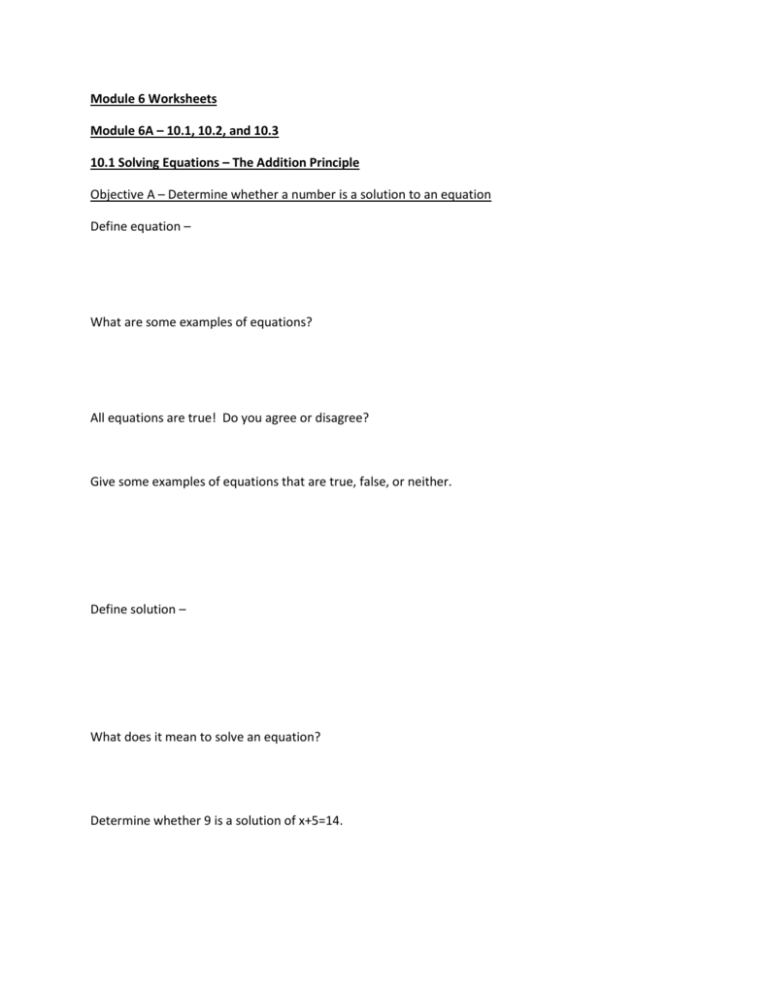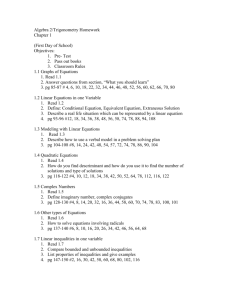Module 6 Worksheets
advertisement

Module 6 Worksheets Module 6A – 10.1, 10.2, and 10.3 10.1 Solving Equations – The Addition Principle Objective A – Determine whether a number is a solution to an equation Define equation – What are some examples of equations? All equations are true! Do you agree or disagree? Give some examples of equations that are true, false, or neither. Define solution – What does it mean to solve an equation? Determine whether 9 is a solution of x+5=14. Determine whether 19 is a solution of 7x=141 Objective B – Solve equations using the addition principle Define equivalent equations – What is the addition principle? What does it allow us to do? Consider x-3=9 Solve: x+7=-4 Solve t-8=-3 Solve: 12 = a-7.9 How do we “undo” subtraction? Solve: 2 5 x 3 2 10.2 Solving Equations – The Multiplication Principle Objective A – Solve equations using the multiplication principle What is the multiplication principle? Solve 5x=45 using both methods in the video. Solve: -4x=92 Solve: 8 = -y Solve: 3 9 r 5 10 Solve: 1.8n=36 10.3 Using the Principles Together Objective A – Solve using the addition and multiplication principles Solve: 5x + 6 = 31 Solve: -5x – 6 = 16 Objective B – Solve equations in which like terms need to be collected. 10.2y – 7.3y = -58 What do you do if there are like terms on both sides of an equation? Solve: 2x – 2 = -3x + 3 True or false: It’s always a good idea to check your solutions. Is there ever a situation where you might use the multiplication principle before the addition principle? Clear fractions and solve: 2 1 1 t 3 4 3 How do we clear fractions? How do we clear decimals? Clear decimals and solve: 10.2y – 7.3y = -58 Objective C – Solve equations by first removing parenthesis and collecting like terms; solve equations with no solutions and equations with infinite number of solutions Solve: 19-(2x+3)=2(x+3)+x What is the procedure for solving equations? 1. 2. 3. 4. 5. 6. So far, all the equations solved have had only one solution!!! Consider: -23+x=x-23 Is -4 a solution? Is 0 a solution? Is 10 a solution? Solve: -23+x=x-23 How many solutions does this equation have? Consider: -23+y=y+25 Is -5 a solution? Is 0 a solution? Is 8 a solution? Solve: -23+y=y+25 How many solutions does this equation have? Module 6B - 10.7 10.7 - Solving Inequalities What is an inequality? What do the following symbols mean? < > ≥ ≤ Which of the following is a solution to x 2 ? a) -2.7 b) 2 Which of the following is a solution for y 6 ? a) 6 Graph t < -3 on a number line. Graph m ≥ -1 on a number line. Graph -3 < x ≤ 4 on a number line. What is the addition principle for inequalities? b) 4 3 Solve and graph. Then write the solution in set builder notation. Which principle will you use? x 8 10 3x 9 2x 6 What is the only difference (except for the symbol) between solving equations and solving inequalities? Fill in the correct symbol using the multiplication principle. For c 0 , if a b then ac bc For c 0 , if a b then ac bc Solve and graph. Then write the solution in set builder notation. Which principle will you use? 5 y 2 2y 1 7 Solve the following. Write the answer in set builder notation. 6 4 y 4 3y y 2 1 5 5 Module 6C – 10.4 “Formulas” Obj. 1 – Evaluate formulas 1) What does it mean to evaluate a formula? Solve the problems along with the video. Consider the formula M 1 t . It takes 10 sec for the sound of thunder to reach you after you have 5 seen a flash of lightning. How far away is the storm? Obj. 2 – Solve for a specified letter 1) . M 1 t Solve this formula for t. 5 2) Solve y = x + b for x. To solve a formula for a given letter, identify the letter and: 1. 2. 3. 4. 5. 3) Solve for b. 4) Solve y=bx+c for x. 5) Solve v 3k for t. t 6) Can you solve for a variable while it is still in the denominator? Yes or No. Module 6D – 10.8 “Applications and problem solving with inequalities” Obj. 1 – Translate to inequalities Translate to an inequality. A number is greater than 8. The number of people is at least 1300. The amount of acid is not to exceed 500 liters. Two more than three times a number is less than thirteen. Obj. 2 – Solve applications with inequalities Solve these problems along with the video. Module 6E – 10.5 and 10.6 10.5 Applications of Percent Objective A – Solve applied problems involving percent What is the first step to solve problems involving percent? “of” translates to ____________________ “is” translates to ____________________ “what number” translates to ____________ “%” translates to _______________________ What is the basic formula for percent problems? What are the three types of percent problems? 1. 2. 3. Solve: What number is 35% of 240? Solve: 14 is 30% of what number? Solve: What percent of 68 is 17? Solve: Solve: 10.6 Applications and Problem-Solving 10.6 Video 1 What are the 5 steps to solving a problem? 1. 2. 3. 4. 5. Type 1: Length/Distance Problems 1. Read the problem, throw out trash What is the total length of the rocket? 2. Translate into an equation What section are all other sections relative to? (The variable) 3. Solve the equation. 4. Check the solution. 5. State the answer clearly. 10.6 Video 2 Type 2: Consecutive Number Problems What are consecutive numbers? List some examples. Can you translate consecutive numbers to an expression? Follow the video. What are consecutive odd numbers? Translate these to an expression. What about consecutive even? Work along with the video as the instructor solves this problem. 1. Read the problem - throw out trash. 2. Translate to an equation. 3. Solve the equation. 4. Check the equation. 5. State the answer clearly. Type 3: Fixed Cost/Variable Cost Problems What is a fixed cost? What is a variable cost? What is the general form for these problems? Solve the problem in the space below along with the instructor. 10.6 Video 3 Type 4: Average Problems 1. Read the problem. Throw out the trash. 2. Translate to an equation. How do you take an average? Identify your variables. 3. Solve the equation. 4. Check the answer. 5. State the answer. What is the general formula for solving these types of problems? Explain. What is: EV? SV? Rate? Solve this problem along with the instructor in the video.





